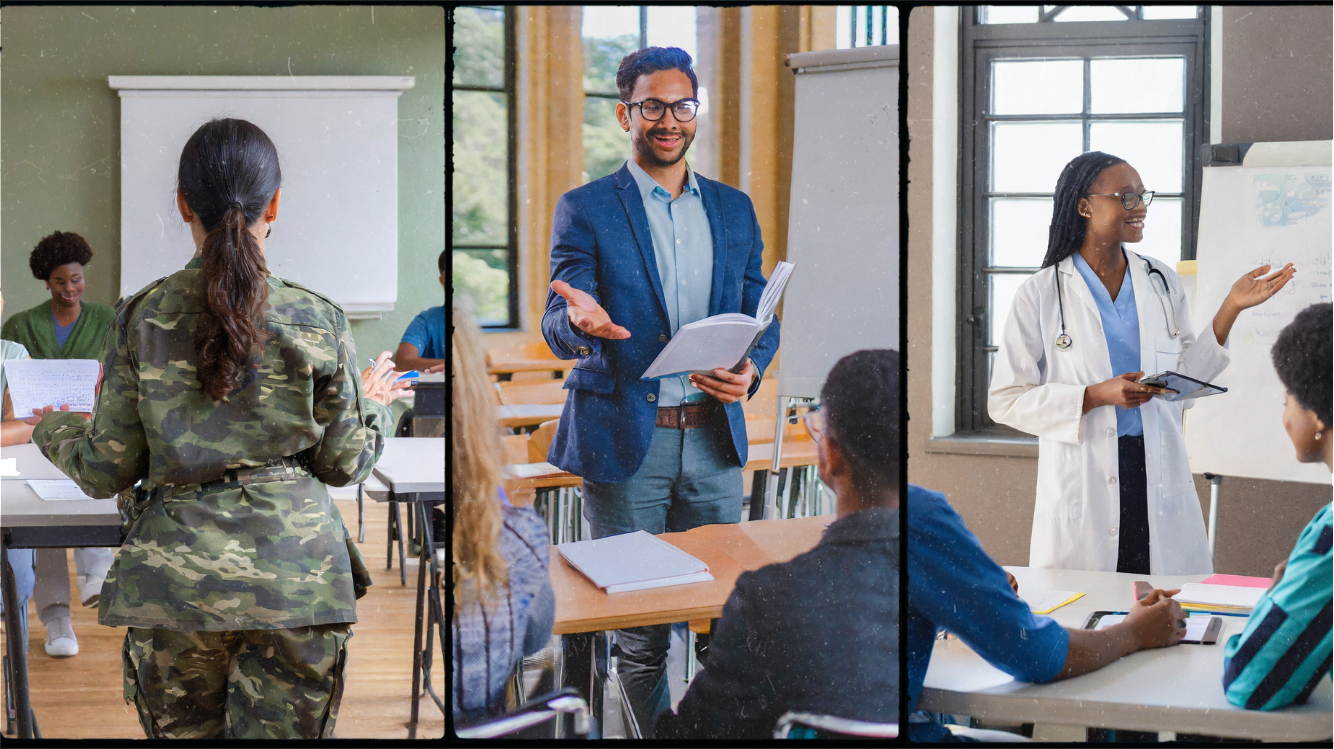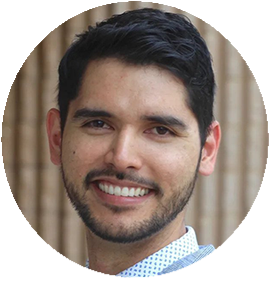Enhancing Civics Instruction with Guest Speakers: Insights from the Adult ESOL Classroom

by Xavier Muñoz
How do you teach in a way that keeps learners engaged and excited about what they’re learning? One idea: Bring guest speakers to class. New faces and voices who are experts in various subject matters can offer a wealth of learning opportunities for learners, from finding out about available community resources to better understanding key aspects of United States (U.S.) culture and government to simply making learners more comfortable in speaking with professionals (doctors, politicians, mental health experts, police officers, etc.). In this article, intermediate-level ESOL teachers Karen and Kathleen from the English Empowerment Center offer insights into the benefits and challenges of guest speakers to support civics education in person and online.
Connecting the Classroom to the Community
Guest speakers provide a unique opportunity to connect adult learners with real-world experiences and diverse perspectives, significantly enhancing their understanding of civic topics.
Cultural Perspectives.
Holidays, like Veterans Day, can be good occasions for guest speakers. Kathleen and Karen reflect on the profound effect guest speakers have had on changing learner perceptions, especially concerning topics like the military, which may be viewed differently in other countries:
“We had some students from countries where the military is terrifying… So the idea that members of the military would be celebrated was kind of a novel concept for them and a good thing for them to start to understand about the United States.” – Kathleen
Karen goes on to say,
“On Parents Day or at various events, you could well pass someone in an army uniform walking down the hall at the same time you’re going to your child’s classroom or you could see them in Starbucks or on the Metro here in D.C. That is just another parent or just another community member.”
 Navigating Systems and Services.
Navigating Systems and Services.
Guest speakers can make topics and concepts more relevant. For example, as part of the unit on health, Kathleen invited a social worker to talk about mental health issues and to give them information on resources in the area.
When learners go to a doctor’s office or hospital, they are often accompanied by a translator like a spouse or other family member. In another semester, Karen brought in a retired doctor and tried to structure role plays for learners to practice with the doctor in Zoom breakout rooms. Learners opted to talk about their own real health concerns and questions. In doing so, learners built up their confidence in having a more direct relationship with a healthcare provider.
Guest speakers can also inform learners about education and workforce training options and resources available to them. For example, an instructor from the adult ESOL program within Fairfax County Public Schools shared about higher-level and specialized classes for those who graduate from the English Empowerment Center and are looking to continue their education. And, there are plans to bring in a speaker from an organization specializing in supporting internationally trained professionals to restart their careers.
Key Considerations
1. Tailor the Content for Comprehensibility.
Teachers and programs need to carefully select and prepare the guest speakers to ensure engagement and relevance. Effective guest speakers should be able to adapt their content and style to the learners’ language level and interests. They need to do more than just talk about the topic or about their job. They need to connect and engage with the learners dynamically. Not surprisingly, speakers with teaching experience are a natural ft!
One particularly successful guest speaker was the Associate Dean of ESL from the local community college. An immigrant herself, she “had a very clear presentation that was geared towards the learners’ level of speaking and comprehension. She was very accessible and open to questions… her whole presentation was accessible and at their level.” – Kathleen
But it’s okay for a guest speaker to be new to talking with an immigrant or English learner audience. The teacher should review the presentation materials beforehand and suggest what to cut, simplify, or edit.
2. Engage Learners with the Guest Speaker.
Active learner participation enhances the impact of the session. But before then, teachers need to create an “intellectually and socially safe” learning environment. For classes that meet 2 days a week, 2 hours a day, waiting a month before your first guest speaker gives you time to build a strong learning relationship.
“They trust us. They know we are all on their side and working to help them, and so they assume that anybody we bring in is going to be kind of a safe person.” – Kathleen
Support learners’ language development. When their class had a special opportunity to meet an elected official, Karen and Kathleen taught the class what things a U.S. representative would know about; then they helped learners formulate their questions for that elected official. When you can select speakers that align with the curriculum unit, schedule the guest speaker in the middle or toward the end of the unit so the class has already learned relevant vocabulary.
Plan for one-on-one or small group time with the speaker. On Zoom when all you see are black boxes, it can be difficult to assess the level of engagement. Even if the speaker isn’t effective at adapting to the learners’ comprehension level, they could repeat a portion of their content (e.g., what to do if you want to find resources) with small groups. Or, identify whether there is a relevant role-play that learners could practice. With a healthcare professional, learners could practice talking about a health problem and asking for advice.
3. Maximize the Learning Opportunity Afterward.
Teachers should use follow-up activities to reinforce the learning from the guest speaker sessions. One idea is to fold it into an activity on writing thank-you notes, using effective writing instruction techniques like brainstorming something they appreciated hearing about and then analyzing a sample thank-you letter or email. More recently, Karen saw success with an asset-based strategy of having each learner give their own “guest speaker” talk to the class. Each learner chose a topic they were an expert on (e.g., foods in Afghanistan compared to in the U.S., getting a driver’s license in the U.S., caring for a newborn and dealing with issues of older sibling resentment). Learners had time to write on their topic in English or even in their native language before presenting to the class.
Concluding Thoughts
The experiences of Karen and Kathleen at the English Empowerment Center demonstrate how, when thoughtfully integrated, guest speakers can enrich civics education for adult learners through relevance, confidence building, and language development. As they continue to experiment with what works best, they are excited to get more suggestions from learners on who they want to hear from and to work with program staff to compile a list of interested and available guest speakers.
Effective Practices
1. Selecting a Speaker:
Choose guest speakers for topics relevant to the curriculum or speakers who can present diverse perspectives and have experience talking with English learners; be aware of students’ backgrounds, particularly cultural differences toward gender dynamics.
2. Preparing the Speaker:
Inform speakers about students’ needs and interests; review and simplify their presentation material (6–10 slides recommended); and provide guidance on using plain language.
3. Managing the Time:
Set a time limit (20 minutes for an intermediate ESOl class) but be flexible depending on student engagement level.
4. Engaging the Learners:
Encourage students to prepare questions in advance; teach them appropriate ways to address the speaker depending on their profession; arrange for 1-on-1 or small group interaction with the speaker in breakout rooms.
5. Follow-Up Activities:
Add on language development activities like writing thank-you notes, students’ presenting on their own topics of choice, or sharing curated reading lists.
 Xavier Muñoz (he/him) oversees adult English language acquisition, family literacy, and workplace literacy classes as well as distance learning, digital literacy, and student advising initiatives at the English Empowerment Center. He holds a teaching English as a second language (TESOL) Certificate and an M.A. in TESOL. He has also earned a Civics Education Leader badge from World Education for participating in the Teaching Skills That Matter TSTM – SkillBlox project.
Xavier Muñoz (he/him) oversees adult English language acquisition, family literacy, and workplace literacy classes as well as distance learning, digital literacy, and student advising initiatives at the English Empowerment Center. He holds a teaching English as a second language (TESOL) Certificate and an M.A. in TESOL. He has also earned a Civics Education Leader badge from World Education for participating in the Teaching Skills That Matter TSTM – SkillBlox project.